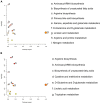The Response of Fecal Microbiota and Host Metabolome in Dairy Cows Following Rumen Fluid Transplantation
- PMID: 35923396
- PMCID: PMC9343124
- DOI: 10.3389/fmicb.2022.940158
The Response of Fecal Microbiota and Host Metabolome in Dairy Cows Following Rumen Fluid Transplantation
Abstract
Rumen fluid transplantation (RFT) has been used to rebuild rumen bacterial homeostasis, reshape rumen function, and restore rumen fermentation, whereas the effect of RFT on fecal microbiota and host metabolism in cows remains poorly understood. In our study, a combination of 16S rRNA sequencing and serum non-targeted metabolomics was performed to investigate the response of fecal microbiota and serum metabolome in dairy cows following RFT. Twenty-four prepartum dairy cows were randomly assigned to 3 groups (n = 8) for infusion of either saline (Con), fresh rumen fluid (FR), or sterilized rumen fluid (SR) after calving. Fourteen days after calving, fecal microbiota and serum metabolome were analyzed. The sequencing data of fecal samples revealed no changes in alpha diversity and relative abundance of dominant genera such as Ruminococcaceae UCG-005, Rikenellaceae RC9 gut and Eubacterium coprostanoligenes. However, the other genus level taxa, such as Eubacterium oxidoreducens, Anaerorhabdus furcosa, Bacillus and Selenomonas, showed distinct changes following RFT. Serum metabolome analysis showed that FR or SR infusion affected amino acids metabolism, bile acids metabolism and fatty acids metabolism (including linoleic acid, oleic acid and palmitic acid). Furthermore, correlation analysis showed that taxa from genera Clostridiales were positively correlated with metabolites involved in tryptophan and bile acid metabolisms, such as OTU1039 from genera unclassified o_Clostridiales was positively correlated to indoleacetic acid and taurolithocholic acid. These results suggest that RFT altered the composition of the fecal microbiota and modulated microbial metabolic pathways, which is vital for the development and safety assessment of rumen microbial intervention strategies.
Keywords: dairy cows; fecal microbiota; rumen microbiota transplantation; sequencing; serum metabolome.
Copyright © 2022 Huang, Zheng, Men, Wang and Li.
Conflict of interest statement
The authors declare that the research was conducted in the absence of any commercial or financial relationships that could be construed as a potential conflict of interest.
Figures




Similar articles
-
Altered Fecal Microbiome and Correlations of the Metabolome with Plasma Metabolites in Dairy Cows with Left Displaced Abomasum.Microbiol Spectr. 2022 Dec 21;10(6):e0197222. doi: 10.1128/spectrum.01972-22. Epub 2022 Oct 12. Microbiol Spectr. 2022. PMID: 36222683 Free PMC article.
-
Fecal metabonomics combined with 16S rRNA gene sequencing to analyze the changes of gut microbiota in rats with kidney-yang deficiency syndrome and the intervention effect of You-gui pill.J Ethnopharmacol. 2019 Nov 15;244:112139. doi: 10.1016/j.jep.2019.112139. Epub 2019 Aug 8. J Ethnopharmacol. 2019. PMID: 31401318
-
Ruminal Degradation of Rumen-Protected Glucose Influences the Ruminal Microbiota and Metabolites in Early-Lactation Dairy Cows.Appl Environ Microbiol. 2021 Jan 4;87(2):e01908-20. doi: 10.1128/AEM.01908-20. Print 2021 Jan 4. Appl Environ Microbiol. 2021. PMID: 33097510 Free PMC article.
-
Comparison of Fecal Microbiota Communities between Primiparous and Multiparous Cows during Non-Pregnancy and Pregnancy.Animals (Basel). 2023 Feb 27;13(5):869. doi: 10.3390/ani13050869. Animals (Basel). 2023. PMID: 36899725 Free PMC article.
-
Multi-omics reveals that the rumen microbiome and its metabolome together with the host metabolome contribute to individualized dairy cow performance.Microbiome. 2020 May 12;8(1):64. doi: 10.1186/s40168-020-00819-8. Microbiome. 2020. PMID: 32398126 Free PMC article.
Cited by
-
Impact of a Saccharomyces cerevisiae fermentation product during an intestinal barrier challenge in lactating Holstein cows on ileal microbiota and markers of tissue structure and immunity.J Anim Sci. 2023 Jan 3;101:skad309. doi: 10.1093/jas/skad309. J Anim Sci. 2023. PMID: 37721866 Free PMC article.
-
The Profound Influence of Gut Microbiome and Extracellular Vesicles on Animal Health and Disease.Int J Mol Sci. 2024 Apr 4;25(7):4024. doi: 10.3390/ijms25074024. Int J Mol Sci. 2024. PMID: 38612834 Free PMC article. Review.
-
Comparative analysis of functional diversity of rumen microbiome in bison and beef heifers.Appl Environ Microbiol. 2023 Dec 21;89(12):e0132023. doi: 10.1128/aem.01320-23. Epub 2023 Dec 6. Appl Environ Microbiol. 2023. PMID: 38054735 Free PMC article.
-
Differences in Milk Fatty Acids Profile of Two Breeds of Water Buffaloes Explained by Their Gastrointestinal Microbiota.Animals (Basel). 2024 Jul 23;14(15):2146. doi: 10.3390/ani14152146. Animals (Basel). 2024. PMID: 39123672 Free PMC article.
-
Integrating 16S rRNA Sequencing and LC-MS-Based Metabolomics to Evaluate the Effects of Dietary Crude Protein on Ruminal Morphology, Fermentation Parameter and Digestive Enzyme Activity in Tibetan Sheep.Animals (Basel). 2024 Jul 24;14(15):2149. doi: 10.3390/ani14152149. Animals (Basel). 2024. PMID: 39123675 Free PMC article.
References
-
- Benjamini Y., Hochberg Y. (1995). Controlling the false discovery rate: a practical and powerful approach to multiple testing. J. Royal. Statis. Soc. 57 289–300. 10.1111/j.2517-6161.1995.tb02031.x - DOI
LinkOut - more resources
Full Text Sources
Research Materials

